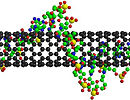Researchers enlist DNA to bring carbon nanotubes’ promise closer to reality
Tailored sequences of DNA lead to breakthrough in the campaign to sort and separate CNTs
Advertisement
A team of researchers from DuPont and Lehigh University has reported a breakthrough in the quest to produce carbon nanotubes (CNTs) that are suitable for use in electronics, medicine and other applications.
In an article published in the July 9 issue of Nature, the group says it has developed a DNA-based method that sorts and separates specific types of CNTs from a mixture.
CNTs are long, narrow cylinders of graphite with a broad range of electronic, thermal and structural properties that vary according to the tubes' shape and structure. This versatility gives CNTs great promise in electronics, lasers, sensors and biomedicine, and as strengthening elements in composite materials.
Current methods of producing CNTs yield mixtures of tubes with different diameters and symmetry, or "chirality." Before the tubes can be used, however, they must be disentangled from a mixture and "purified" into separate species of CNTs of the same electronic type.
"A systematic method of purifying every single-chirality species of the same electronic type from a synthetic mixture of single-walled nanotubes is highly desirable," the DuPont-Lehigh group wrote in Nature, "but the task has proven to be insurmountable to date."
The Nature article is titled "DNA sequence motifs for structure-specific recognition and separation of carbon nanotubes." Its authors are Ming Zheng, Xiaomin Tu, Anand Jagota and Suresh Manohar. Zheng and Tu are scientists with DuPont Central Research and Development. Jagota is a professor of chemical engineering at Lehigh. Manohar is a graduate student in chemical engineering at Lehigh.
In 2003, a team of scientists from DuPont, MIT and the University of Illinois at Urbana-Champaign developed a new method of separating metallic CNTs from semiconducting CNTs using single-stranded DNA and anion-exchange chromatography. The scientists reported their discovery in Science.
The new results improve on the 2003 results by identifying more than 20 DNA short sequences that can recognize individual types, or species, of carbon nanotubes and purify them from a mixture.
The new method utilizes tailored DNA sequences and "allows the purification of all 12 major single-chirality semiconducting species from a synthetic mixture, with sufficient yield for both fundamental studies and application development."
The current experiments were conducted at DuPont by Tu and Zheng, while Manohar and Jagota developed structural models using molecular simulations.
"The interesting discovery made by Tu and Zheng," says Jagota, "is that if you choose the DNA sequence correctly, it recognizes a particular type of CNT and enables us to sort that variety cleanly. This kind of practical improvement brings us closer to manufacturing possibility."
How does DNA recognize and sort types of CNTs? The DuPont-Lehigh team says this could be related to DNA's ability to form a structure different from its usual double helix when wrapping around the CNTs.
An alpha helix, like scotch tape wrapped around a pencil to form a tube, is a common shape seen in proteins, one of the main classes of biological molecules. Another common structure seen in proteins is the beta sheet. If you take a long strand in your palm, stretch it out to the tip of your index finger, loop it to your middle finger, then back to your palm, then out to your ring finger, back to your palm and out to your little finger, you form a type of beta sheet.
"Such a structure is not known for DNA," says Jagota, "but we've shown that it is possible as long as you allow the DNA to adsorb on a surface. If the surface is cylindrical, like a CNT, you get a variant called the beta-barrel."
While the researchers do not have absolute proof, they say circumstantial evidence strongly supports their hypothesis that the DNA is forming this well-organized structure and that it recognizes a specific CNT in the same way that biological molecules recognize each other by structure.
Jagota, who directs Lehigh's bioengineering program, says the biomedical ramifications of the researchers' discovery are particularly exciting. One potential application for CNTs, for example, is to use them as substrates that can deliver biological molecules to cells in the body.
"We are very interested in the biomedical applications of this work," says Jagota. "What does this say about how DNA interacts with nanomaterials? Will they be harmful inside the body? Can we take advantage of the interaction for therapeutic applications? It's a big open field."
Other news from the department science
These products might interest you
Most read news
More news from our other portals
See the theme worlds for related content
Topic world Sensor technology
Sensor technology has revolutionized the chemical industry by providing accurate, timely and reliable data across a wide range of processes. From monitoring critical parameters in production lines to early detection of potential malfunctions or hazards, sensors are the silent sentinels that ensure quality, efficiency and safety.

Topic world Sensor technology
Sensor technology has revolutionized the chemical industry by providing accurate, timely and reliable data across a wide range of processes. From monitoring critical parameters in production lines to early detection of potential malfunctions or hazards, sensors are the silent sentinels that ensure quality, efficiency and safety.




























































